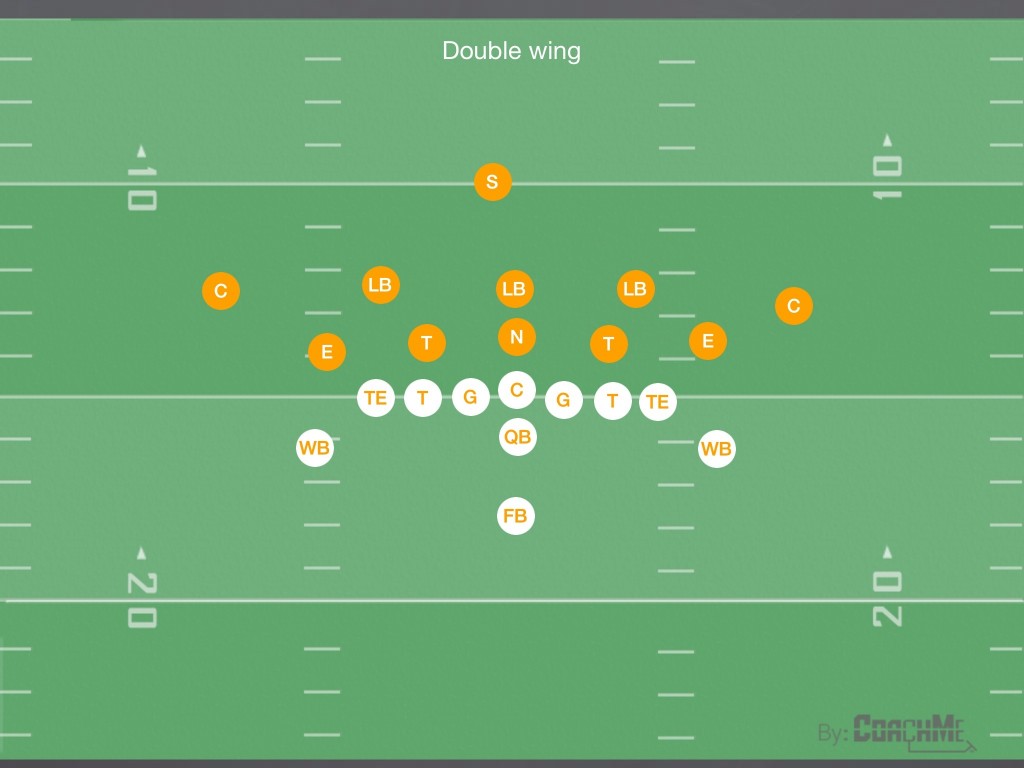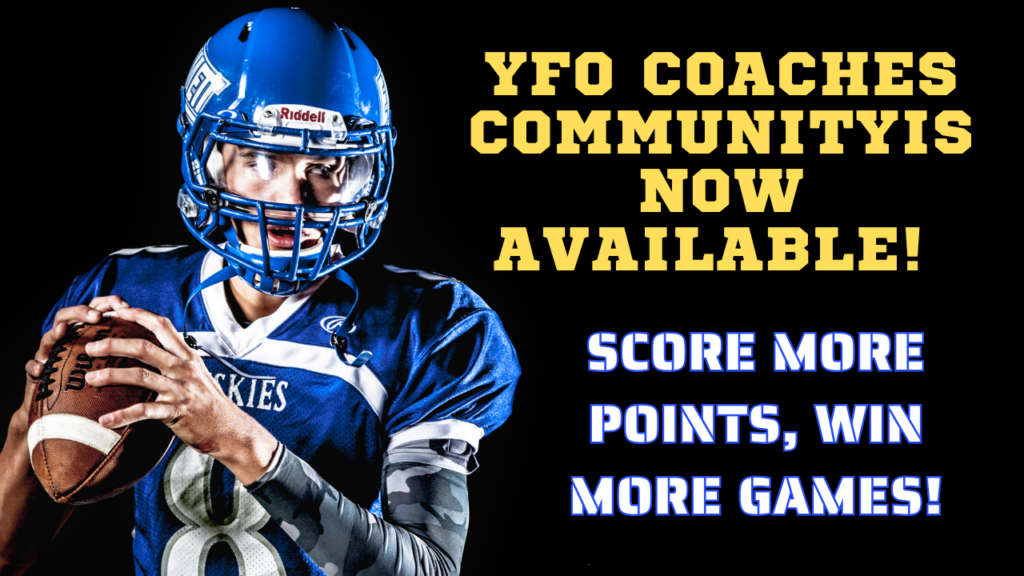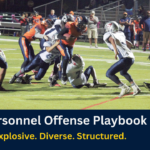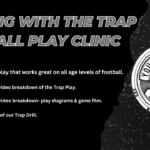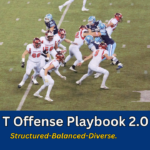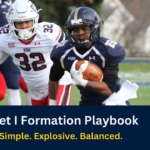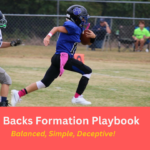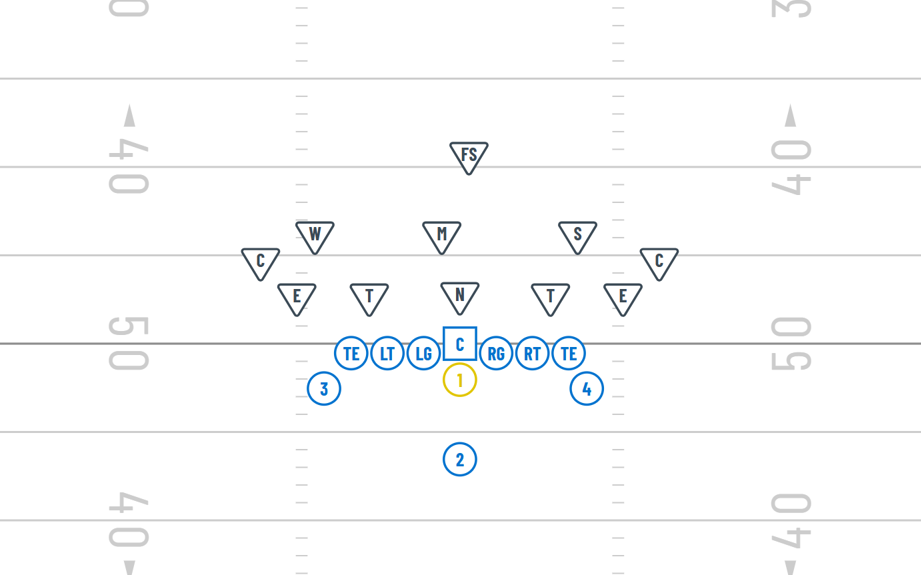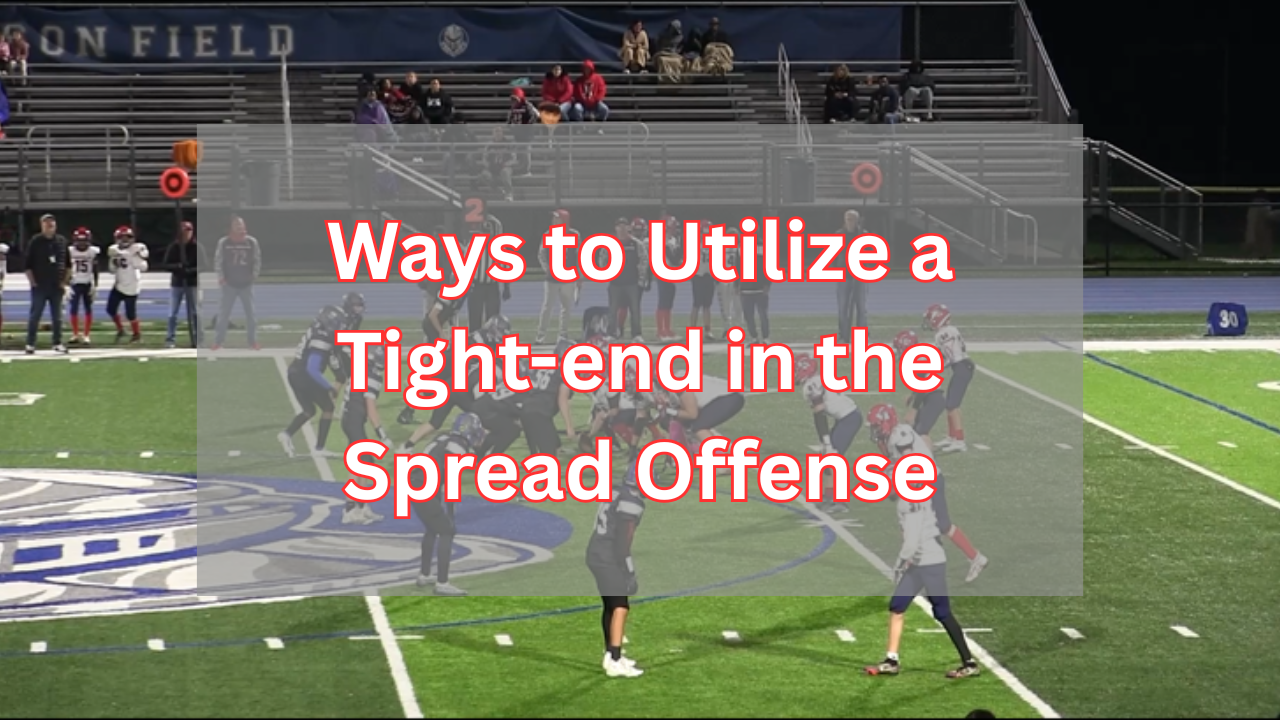The Double Wing Offense in Youth Football
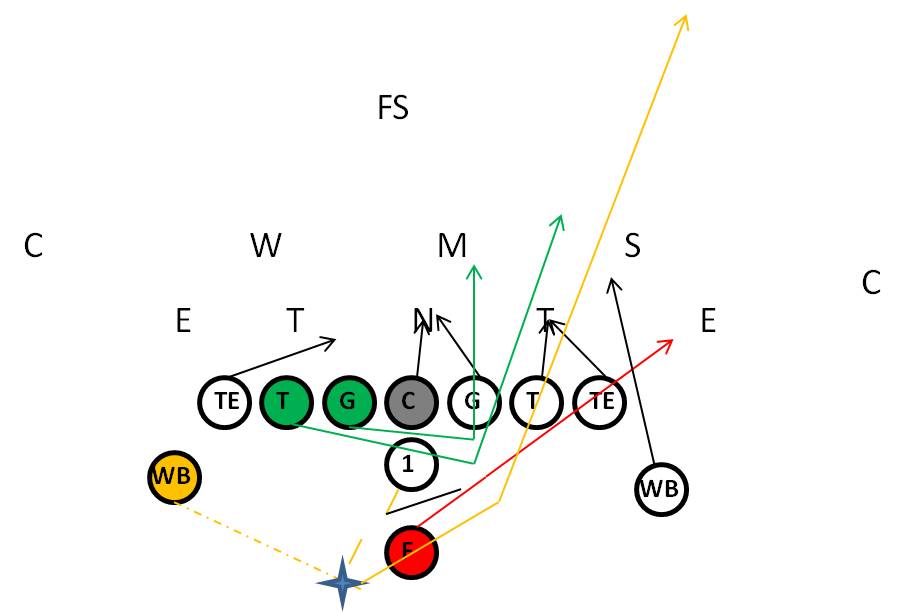
The Double Wing Offense
The double wing offense is an offense that features two tight-ends, two wing backs, one fullback, and a QB in the backfield. This offense utilizes zero line splits. This will allow the offensive line to execute double team and down blocks on the defense very easily. Utilizing zero line splits also reduce the distance the pulling linemen have to run when they are lead blocking or kicking out a defender. The double wing offense is a power offense that really gets numbers (blockers) to the point of attack. This offense also has a very good play-action passing game.
The Double Wing offense is one of the most physical, disciplined, and misunderstood offensive systems in football. Often referred to as a “smashmouth” scheme, it’s designed to control the clock, dominate the line of scrimmage, and wear down opposing defenses. Developed and popularized by coaches like Don Markham and Jack Greggory, the Double Wing thrives on precision, toughness, and team execution.
Double Wing Formation & Alignment
The standard Double Wing formation consists of:
-
Two tight ends (TEs) aligned close to the offensive tackles.
-
Two wingbacks (WBs) positioned just outside and behind the TEs.
-
A fullback (FB) directly behind the quarterback (QB).
-
The quarterback under center.
This tight, compact formation gives the appearance of limited options, but it’s deceptive and full of potential misdirection and power.
Core Principles of the Double Wing Offense
-
Power Football
The heart of the Double Wing is the power run game. The offense uses double teams, down blocks, and pulling linemen to create overwhelming angles at the point of attack. The most famous play—”Power Toss” or “Super Power”—features the backside guard and tight end pulling, a kick-out block on the end man, and a lead block through the hole by the fullback or wing. -
Misdirection and Deception
Though run-heavy, the Double Wing includes traps, counters, and sweeps that punish aggressive defenses. Because all backs start from similar depths, the defense has little time to read the play direction. The wingback reverse, trap, and counter criss-cross are deadly when executed well. -
Time of Possession
The offense is built to grind out drives and control the clock. Drives of 10+ plays are common, and the system thrives in short-yardage situations. -
Team Cohesion
Success in the Double Wing depends on total buy-in. Every player, especially the offensive line, must execute with discipline. There are no “superstars”—it’s a system of unity, where even wide receivers are expected to block like linemen.
See Also: 4 Ways to Run the Double Wing Power
The Double Offense Utilized zero line splits:
Benefits of zero line splits:
- Wedge blocking friendly.
- Able to pick up blitzes, slants, & stunts easily.
- Pulling and kick-out block friendly formation.
- Brings the defense in and makes the defense commit defenders into the box- which opens up the play-action passing game.
- Easier to pass block.
- Less distance a pulling lineman has to travel to execute his lead or kick-out block.
- The offensive linemen are a little farther back so that defensive linemen can’t cut them down. It also allows them to pull without getting caught up in the mix.
Most teams implement either a double team and/or down blocking scheme. Down blocking has all the offensive linemen block down on defenders inside of them. In the down blocking scheme, there is a pulling linemen or fullback that will kick-out the end man on the line of scrimmage. Many double wing offenses will utilize double team blocking at the point of attack as well. Teams tend to use the double team blocking scheme more so on their power series. We play a very good double wing team every year and they apply the down blocking scheme and the double team scheme.
The double wing offense is easy to implement. It is an effective offense in youth football. The wedge play is very difficult to stop. To execute this offense you will need offensive linemen that can pull. Many double wing offenses will have their backside guard and tackle pull, which means you will need 4 kids on the field that can pull. In addition- you will also need to teach the back-up linemen how & when to pull. The double wing coaches that pull both linemen tell me that they have every single player on their team practice pulling (makes sense).
Here is a standard double wing formation (there are other formations that the double wing offense can be executed out of):
The power play out of the double wing offense is the staple mark of this offense. This play will flood the point of attack with blockers and will utilize double teams at the point of attack.
Power Play (double team):
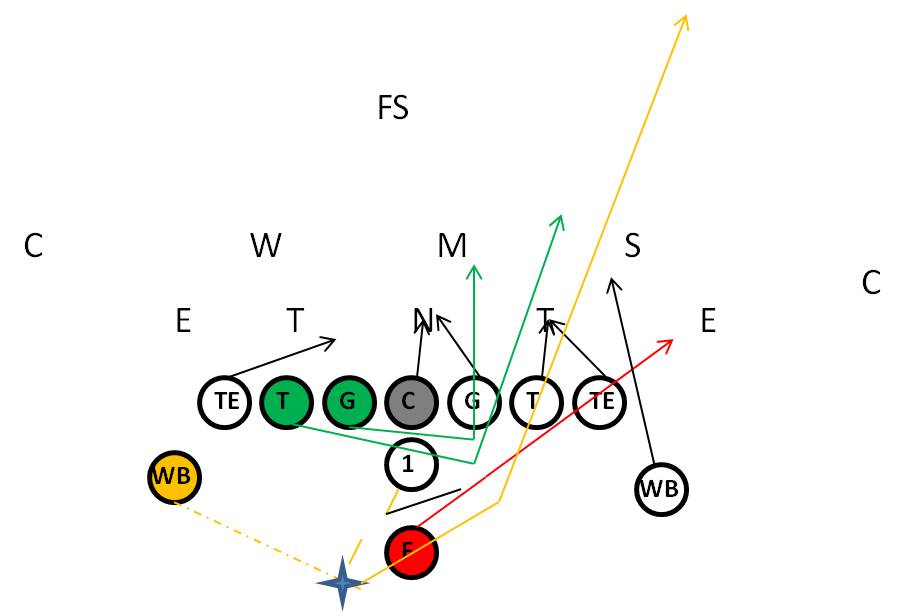
This football play features double teams at the point of attack. The play-side defensive tackle and nose guard will get double teamed. The play-side defensive end will be kicked out by the fullback. The back-side guard & tackle will pull. The PS guard will pull and look to get onto the middle linebacker. The guard’s pull path will always be right off the center and PS guard’s double team block. The pulling guard must always look to block inside to outside (pick up any A-B blitzes). The pulling tackle will lead block through the hole. The pulling path will be right off the tackle and TE’s double team block.
The QB will open up to the motion side and give a quick pitch to the wing back going in motion. After the QB pitches the ball he can turn and lead block. You can have the QB carry out a fake if you don’t want him blocking. The WB will go in a 3 step backwards motion and will receive a quick pitch and get downhill behind the double teams. The motion player cannot go or lean forward until the ball is snapped.
Here is a double wing offense video:
Power Play (down blocking):
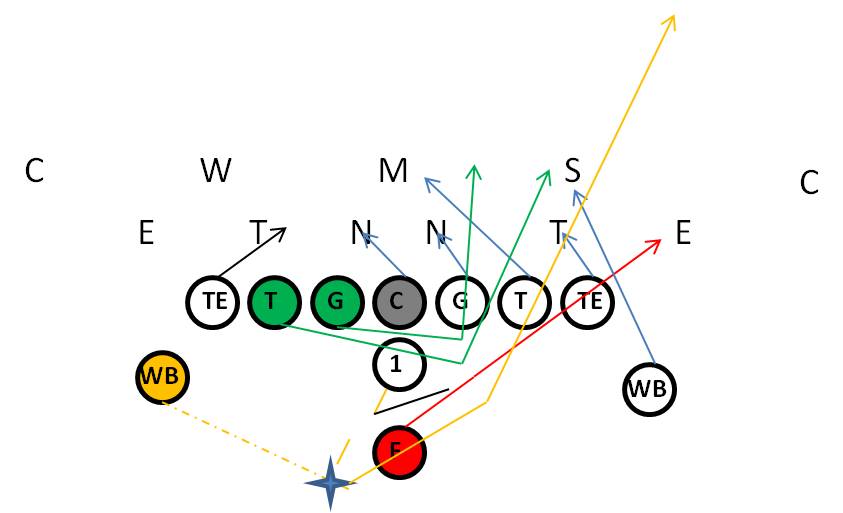
The power play out of the double wing offense can also utilize a down blocking scheme. Down blocking will allow the offense to take advantage of blocking angles. Down blocking rules are as followed: Gap- Down- Backer. If you are having problems with a C-gap defensive end you can have your PS WB down block on him. We call that our “Hammer” block.
If the defenses are keying your fullback you can have the pulling guard kick-out the defensive end and just have the FB fake trap and fill back-side A-gap. Many times defenses will say well, lets follow the fullback, he will take us to the ball. When you have the full back fake trap, it will definitely hold that middle linebacker. This is an excellent key breaker.
In this episode, Coach Jason Brisson dives deep into one of the most powerful and time-tested offensive systems in football — the Double Wing Offense. Whether you’re a youth coach looking to dominate on game day or just curious about the ins and outs of this smashmouth scheme, this episode is for you.
Counter Play
This counter play is a very explosive play. Once the power gets going defenses will adjust to the motion side. Once the defense starts committing to stopping the power, the counter play will gut the defense for big yardage. Many times you will see these counters go for big time yardage. The QB opens up to the motion side, gets depth into the back and executes an inside hand-off to the WB. It is the vital that the WB in motion fakes like he is getting the ball. This diagram features the down blocking scheme, but you can use double teams at the point of attack as well. Even though this is a counter play (counter action in the backfield), it is essentially a power play.
Power Pass
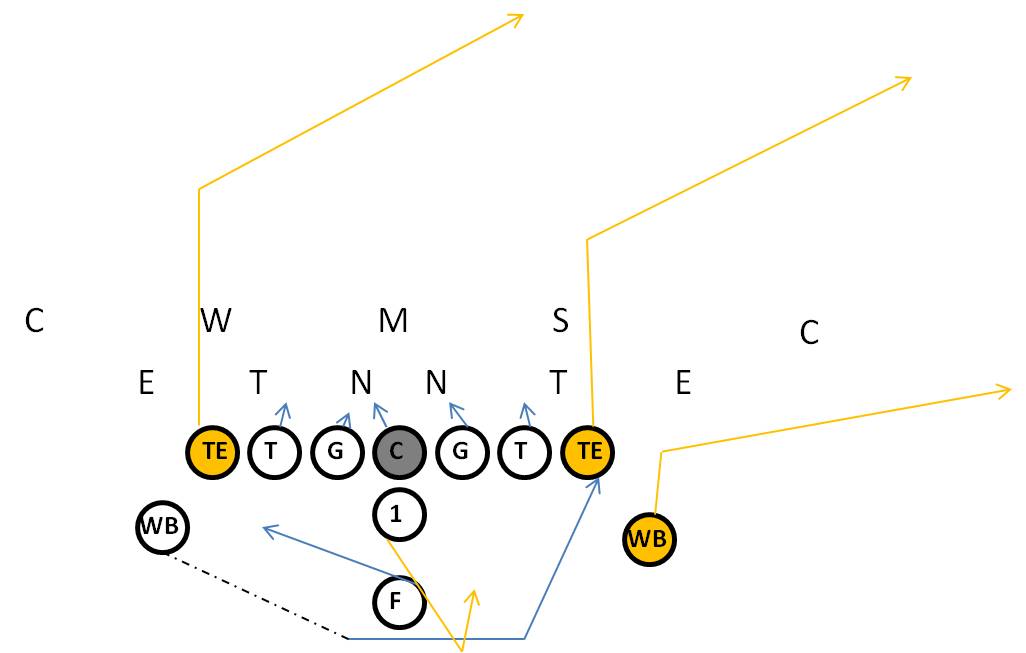
Double Wing Offense Cons:
- Pulling OL will take you to the play. Key guards. Use cross keys on the wing backs.
- There aren’t many youth football coaches that implement key breakers.
- Need multiple kids that can pull.
- Compressed formation- if you are competing against an opposing defense that dominates the line of scrimmage you are in troubles.
- Limits the number of formations that could be implemented. But, I am sure double wing coaches will disagree. We do face a double wing team that tries to spread us out.
Want more plays? Here you go: Youth Football Plays

